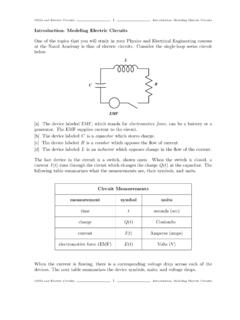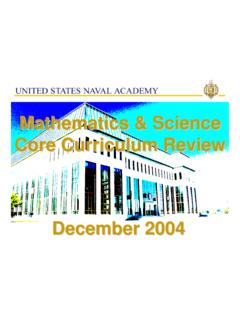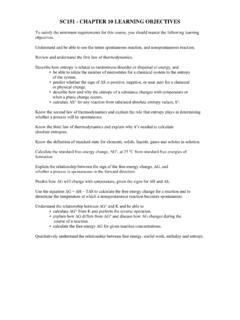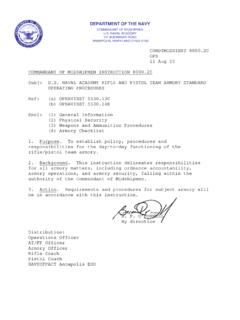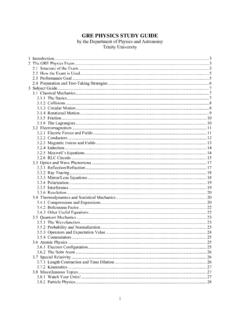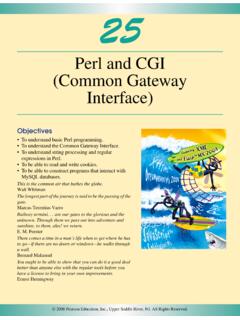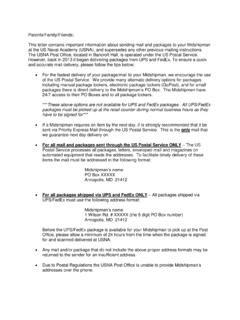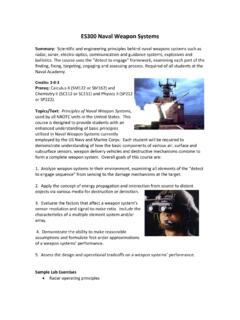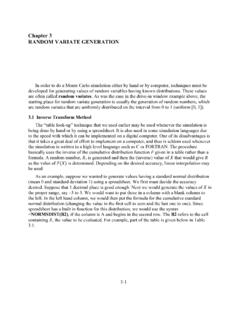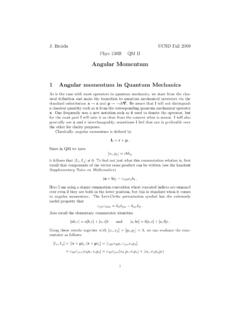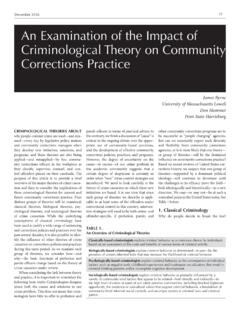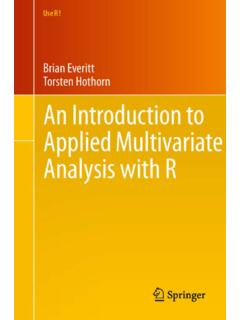Transcription of MATLAB time-based simulations of projectile motion ...
1 MATLAB time-based simulations ofprojectile motion , pendulum oscillation, andwater dischargeKaan Yetilmezsoy1,3and Carl E Mungan21 Department of Environmental Engineering, Faculty of Civil Engineering, YildizTechnical University, 34220, Davutpasa, Esenler, Istanbul, Turkey2 Physics Department, US Naval Academy, Annapolis, MD 21402-1363, United Statesof 27 March 2018, revised 8 July 2018 Accepted for publication 17 August 2018 Published 24 September 2018 AbstractIn addition to teaching undergraduate technical majors about theory andexperiments, an important component of their instruction should be to developproficiency in using computers for simulations and data presentation. A par-ticularly appropriate course for this purpose is classical mechanics because oneof the primary goals of that course is to simulate the motion of physicalsystems, which is greatly aided by visualizations that help to build students intuition about expected behaviors.
2 As a demonstration of the ease with whichthis objective can be accomplished using the MATLAB software package,fully executable scripts are presented here for three commonly studied sys-tems: point projectiles, simple pendula, and waterflowing out of a hole in atank. It is much easier for students to edit a functioning script than to try towrite their own from scratch. However, the present scripts are sufficientlyshort and well-documented that instructors can readily ask their students tomodify and adapt them according to their local instructional environmentsand : computational simulation, projectile motion , simple pendulum,water discharge, MATLAB (Somefigures may appear in colour only in the online journal)European Journal of PhysicsEur. J. (2018)065803(18pp) to whom any correspondence should be +18$ 2018 European Physical Society Printed in the UK11.
3 IntroductionIn today s world, educators and students are aware of the needs of the science educationcommunity regarding the use of computation in physics. There is no doubt that conventionalhand calculations are often laborious and time-consuming when the number of inputs isincreased, and/or different initial parameters are introduced in every new scenario of acomplicated problem. More importantly, computer-aided techniques are inevitable in theanalysis of many physical systems( structural mechanics, andfluid mechanics)whosebehavior must be studied both visually and practically under different dynamic theoretical knowledge obtained during lectures is important and can play a sig-nificant role in learning fundamental principles, scientific interpretation of a concept is limitedfor lectures full of theory.
4 Implementation of modern computer technologies( animation,dynamic objects, and visualization of the studied physics phenomena)improves students perception of the material and help them comprehend it[1]. It is essential to teach studentsabout computational methods, modeling knowledge, and simulation experience to encouragethem to create robust and practical solutions to the real-world problems that they will face intheir future careers[2,3].The American Association of Physics Teachers recommends that computer-basedapplications be incorporated into the undergraduate physics curriculum[4]. Topics in clas-sical mechanics are particularly appropriate for this purpose because they are well-suited tocomputational approaches[5]. A synthesis of curriculum development, computational phy-sics, computer science, and physics education will be useful for scientists and studentswishing to write their own simulations and develop their own curricular material[6].
5 Moreover, to support the computer-based applications, inclusion of course-related experi-ments in the curriculum will offer a remarkable opportunity for both students and discipline-specific practitioners to comprehend the theoretical issues in a visual manner[3].In a study performed at the International IT University in Kazakhstan, Dainekoet al[1]investigated the effect of using physics virtual laboratories(PVL)on the performance ofPhysics-1 and Physics-2 courses. PVL was developed in C#(.NET)based on the and realized with the use of 3D modeling by employing Blender and Maya 3 Dsoftware. The authors implemented a PVL software package consisting of nine physicalexperiments( the Atwood machine, Maxwell pendulum, Clement Desormes method,Stefan Boltzmann constant, photoconductivity properties of semiconductors, magneticinduction, direct current laws, Ohm s law for alternating current, and Frank Hertz experi-ment)from various domains of physics integrated into a single curriculum.
6 The study con-cluded that the introduction of innovative computer technologies, such as virtual laboratories,could be used during lectures to enhance the teaching experience and improve educationquality, without large facilities and material on the incorporation of computational science into introductory physicscourses revealed positive results. For instance, at the University of Maryland in the USA,Redish and Wilson[7]proposed a computational environment at thebeginning of an introductory physics course for student programming. The authors sawseveral benefits of teaching physics in a computerized environment. The study concluded thatwhen the computational science tools were combined with introductory physics courses,students were able to discuss real-world problems( projectile motion with air resistance)without needing an intensive mathematical J.
7 (2018)065803K Yetilmezsoy and C E Mungan2A study based on an object-oriented programming language was performed by Lee andLee[8]at Soongsil University in Korea to discuss various aspects of developing interactivephysics education software using Adobe Flash and ActionScript source code for the simu-lator. They demonstrated three examples of interactive simulations ( one-dimensionalkinematics: bus simulator; Newton s laws of motion and law of gravity: motions of twocelestial bodies interacting with gravity; and motions of eight celestial bodies in the solarsystem)based on Flash software that enable students to understand basic concepts in authors concluded that the students could grasp relevant concepts intuitively with thehelp of the object-oriented nature and powerful graphics capability of the study reported by Sherin[9]aimed to compare the performance of two distinctgroups of students(from University of California, Berkeley, USA), an algebra pool and aprogramming pool, where each group consisted offive pairs of students.
8 In the study, thealgebraic physics group was asked to solve traditional textbook problems( shoved block,vertical pitch, air resistance, mass on a spring, stranded skater, buoyant cube, and running inthe rain). The students in the programming physics group were asked to create a set ofsimulations of physical motions( shoved block, dropped ball, tossed ball, air resistance,and mass on a spring)in the Boxer programming environment. The author concluded thatthe algebraic notation of the physics formulas did not indicate causal relations between theparameters, and thus students were directed to discover the existence of balance betweenthe two sides of an equation rather than causal relations. Conversely, programming physicsstudents were encouraged to seek time-varying phenomena and express certain types ofcausal a computer-aided physical multidomain modeling study conducted at the University ofLjubljana in Slovenia, Zupan i and Sodja[10]modeled two mechanical systems(an invertedpendulum and a laboratory helicopter)using MATLAB -Simulink and Dymola-Modelicaenvironments within the framework of an educational application project.
9 For their industrialapplication project, the authors described the modeling and control of thermal and radiationflows in buildings, and two applications from mineral wool production: modeling of amechanical pendulum system, and a recuperator process. The study concluded thatMATLAB-Simulink is a very usable environment for the design of control systems based onlinearized models. Likewise, Modelica-based environments with inverse models can beusable in the control of mechanical study was undertaken by Bozkurt and Ilik[11]at Selcuk University in Turkey toexplore the impact of teaching supported by interactive computer simulations on students beliefs about physics and physics achievements. In the study, simulations (the moving manand energy skate park)benefited from Java and Flash programming resources.
10 According tothe authors analysis, the study concluded that the groups who used computer simulationswere more successful than those who worked with traditional methods, and the courses withinteractive simulations had a positive effect on students beliefs about physics and another study that was conducted by Taubet al[12], at the Weizmann Institute ofScience in Israel, the research objective was to explore the effect of computer science on thestudents conceptual understanding of the physics behind formulas. The programming toolsused in the study were Easy Java simulations and Maxima. To assess the learning effects ofcomputer simulations in physics education, the students were subjected to three differentdisciplines of physics:(i)kinematics(simulation of launching a rocket and intercepting anEur.)

